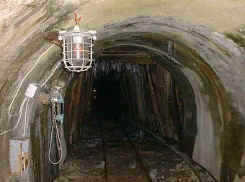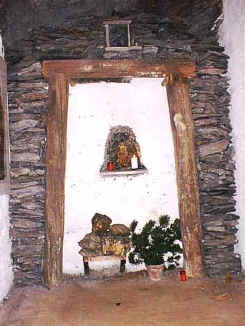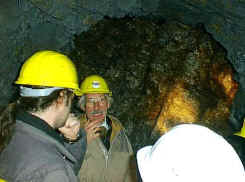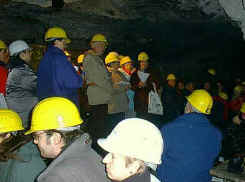Barbara-Feier im Arthurstollen |
|||
|
Barbara-event in the Arthur-tunnel |
|||
| zurück | |||
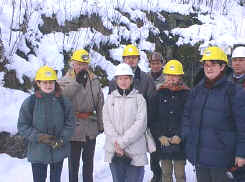
|
Eine Barbarafeier der besonderen Art konnten die Studenten und Gäste von Uni.Doz. Prof. Dr. Clemens Eibner im Montandenkmal Arthurstollen erleben. Die Hl.Barbara gilt als Botin der Hoffnung und des Friedens und ist die Nothelferin der Bergleute. Treffpunkt war der 4. Dezember um 13.00
Uhr vor dem Stolleneingang. Prof. Eibner begrüßte die Studenten und Gäste
und erklärte vorerst den Abbau im Arthurstollen. Die Mineralien waren
Kupferkies (Chalkopyrit) und Pyrit, auch goldhaltiger Tetraedrit und
kobalthaltiger Gersdorffit. Als Nebengesteine (Gangarten) gibt es vor
allem Quarz und Karbonate. Das „Mundloch“ des Stollens empfing
die Besucher in winterlicher Pracht. Eiszapfen glitzerten und zusehens
wurde man in alte Zeiten versetzt Der Keltenstollen veranschaulicht die
Technik der Arbeitswelt bronzezeitlicher Bergleute. Der Besucher betritt
Abbauräume, die jahrtausendelang unverändert erhalten blieben – so,
wie sie der prähistorische Bergmann vor mehr als 3000 Jahren verlassen
hat. Untersuchungen von Grubenholz belegen, daß prähistorische
Bergbauspezialisten bereits vor ca. 3700 Jahren – am Ende der Frühbronzezeit
– Abbaukammern mit hölzernen Einbauten errichteten, die im Stollen noch
zu sehen sind. Tiefer im Stollen befindet sich die
Kapelle mit dem Bildnis
der Hl. Barbara, der Nothelferin der Bergleute. An ihrem Festtag den 4.
Dezember stellt man nach altem Brauch Kirschzweige ins Wasser, die dann
gleichnishaft zu Weihnachten erblühen. Uralt ist der Glaube an die mächtige
Fürbitte dieser Heiligen. Der Turm, mit dem Barbara dargestellt wird, ist
das Symbol jeglicher Gefangenschaft; der Turm der sich plötzlich öffnet,
das Bild der wunderbaren Rettung aus auswegloser Not. Mit einer Ansprache von Prof. Eibner
und der feierlichen Andacht durch Pfarrer Radauer aus Bischofshofen endete
unser Ausflug in den Arthurstollen. Text + Fotos:
Daniel Krainer Auskünfte: |
||
|
Barbara-event in the Arthur-tunnel A very special
Barbara celebration for students and guests was held by Uni.Doz.Prof.Dr.
Clemens Eibner in the Montanmonument Arthurtunnel. The holy Barbara is
messenger for hope and peace and is helper in need for miners. Meeting place
was 4 December, 13:00 h, in front of the tunnel entrance. Prof Eibner
welcomed all the students and guests and firstly gave some explanations
about the way the mining is done in the Arthur tunnel. The minerals: copper
gravel (Chalkopyrit ) and Pyrit, and also Tetraedrit with gold and
Gersdorffit with cobalt. The stones beside are mainly Quarz and Carbonates. The „mouth“
of the tunnel welcomed the visitors in real winter splendor. Iceicles were
shining and you felt like being back in old times. The celt – tunnel shows the technique of the working
world of the miners back in the bronze age. The visitor steps in to mining
rooms which look the same as thousands of years ago – just like the miners
left them about 3000 years ago. Those miners built rooms with wooden
installations back in the early bronze age – and you still can see them. Deeper inside
he tunnel there is a chapel with the picture of the holy Barbara who is the
helper in need for miners. On her day, the 4 December, it is usual to put
cherry-branches into water and they should them bloom at Christmastime. The
believe to this mighty lady is also very very old. Barbara is shown with a
tower is the symbol of any imprisonment; The tower suddenly opens – it is
the picture of a wonderful rescue and a helping in need. The visit to
this tunnel was closed by the speech of Prof. Eibner and a ceremony of the
priest from Radau in Bischofshofen. Report: More
Information: |
|||
